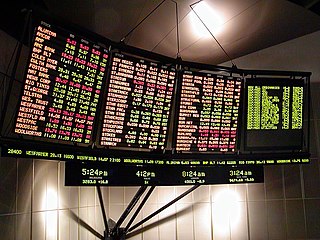An initial public offering (IPO) or stock launch is a public offering in which shares of a company are sold to institutional investors and usually also to retail (individual) investors. An IPO is typically underwritten by one or more investment banks, who also arrange for the shares to be listed on one or more stock exchanges. Through this process, colloquially known as floating, or going public, a privately held company is transformed into a public company. Initial public offerings can be used to raise new equity capital for companies, to monetize the investments of private shareholders such as company founders or private equity investors, and to enable easy trading of existing holdings or future capital raising by becoming publicly traded.

Investment banking pertains to certain activities of a financial services company or a corporate division that engages in providing advisory-based services on financial transactions for clients, such as institutional investors, corporations, and governments. Traditionally associated with corporate finance, such a bank might assist in raising financial capital by underwriting or acting as the client's agent in the issuance of debt or equity securities. An investment bank may also assist companies involved in mergers and acquisitions (M&A) and provide ancillary services such as market making, trading of derivatives and equity securities, FICC services or research. Most investment banks maintain prime brokerage and asset management departments in conjunction with their investment research businesses. As an industry, it is broken up into the Bulge Bracket, Middle Market, and boutique market.

Financial services are economic services tied to finance provided by financial institutions. Financial services encompass a broad range of service sector activities, especially as concerns financial management and consumer finance.
TradeStation Group, Inc. is the parent company of online securities and futures brokerage firms and trading technology companies. It is headquartered in Plantation, Florida, and has offices in New York; Chicago; Richardson, Texas; London; Sydney; and Costa Rica. TradeStation is best known for the technical analysis software and electronic trading platform it provides to active traders and certain institutional trader markets. TradeStation Group was a Nasdaq GS-listed company from 1997 to 2011, until it was acquired by Monex Group, a Tokyo Stock Exchange-listed parent company of one of Japan's leading online securities brokerage firms.
A financial analyst is a professional, undertaking financial analysis for external or internal clients as a core feature of the job. The role may specifically be titled securities analyst, research analyst, equity analyst, investment analyst, or ratings analyst. The job title is a broad one: in banking, and industry more generally, various other analyst-roles cover financial management and (credit) risk management, as opposed to focusing on investments and valuation; these are also discussed in this article.
Dean Witter Reynolds was an American stock brokerage and securities firm catering to a variety of clients. Prior to the company's acquisition, it was among the largest firms in the securities industry with over 9,000 account executives and was among the largest members of the New York Stock Exchange. The company served over 3.2 million clients primarily in the U.S. Dean Witter provided debt and equity underwriting and brokerage as mutual funds and other saving and investment products for individual investors. The company's asset management arm, Dean Witter InterCapital, with total assets of $90.0 billion prior to the acquisition, was one of the largest asset management operations in the U.S.
Front running, also known as tailgating, is the practice of entering into an equity (stock) trade, option, futures contract, derivative, or security-based swap to capitalize on advance, nonpublic knowledge of a large ("block") pending transaction that will influence the price of the underlying security. In essence, it means the practice of engaging in a personal or proprietary securities transaction in advance of a transaction in the same security for a client's account. Front running is considered a form of market manipulation in many markets. Cases typically involve individual brokers or brokerage firms trading stock in and out of undisclosed, unmonitored accounts of relatives or confederates. Institutional and individual investors may also commit a front running violation when they are privy to inside information. A front running firm either buys for its own account before filling customer buy orders that drive up the price, or sells for its own account before filling customer sell orders that drive down the price. Front running is prohibited since the front-runner profits come from nonpublic information, at the expense of its own customers, the block trade, or the public market.
A sell-side analyst works for an investment bank or a brokerage firm and evaluates companies for future earnings growth and other investment criteria. Aside from stimulating buying and selling, the reliability of the research will help the client make a better decision. They sometimes place recommendations on stocks or other securities, typically phrased as "buy", "sell", or "hold." They offer their recommendations to clients. Buying and selling of securities will produce commissions for the brokerage. When a brokerage is also a market maker for the stock being rated, the analyst might influence the price of shares and the brokerage ultimately reap the benefits.
Buy-side analysts ("buy-siders") work for buy side money management firms such as mutual funds, pension funds, trusts, family offices, and hedge funds. They are tasked with identifying investment opportunities that will improve the net worth of the portfolio for which they work.

Bache & Company was a securities firm that provided stock brokerage and investment banking services. The firm, which was founded in 1879, was based in New York, New York.

Securities research is a discipline within the financial services industry. Securities research professionals are known most generally as "analysts", "research analysts", or "securities analysts"; all the foregoing terms are synonymous. Research analysts produce research reports and typically issue a recommendation: buy ("overweight"), hold, or sell ("underweight"); see target price and trade idea.
EFG Hermes Holding S.A.E. is an Egyptian financial services company present in the Middle East, North Africa, Sub-Saharan Africa, and South Asia regions and specializes in securities brokerage, asset management, investment banking, private equity and research in addition to finance lease, factoring, microfinance, Financial technology, mortgage, and insurance. EFG Hermes serves a range of clients including sovereign wealth funds, endowments, corporations, financial institutions, high-net-worth clients and individual customers. EFG Hermes is listed on the Egyptian Exchange (EGX) and London (LSE) stock exchanges. EFG Hermes has offices in Egypt, the United Arab Emirates (UAE), the Kingdom of Saudi Arabia (KSA), Pakistan, Oman, Kuwait, Jordan, Kenya, Nigeria, UK, United States and Bangladesh with over 4,500 people from 25 nationalities. They serve clients from the Middle East, North Africa, Europe and the United States. Currently, EFG Holding is listed as number 13 in Forbes' Top 50 Listed Companies in Egypt 2023.
Gideon Isaiah Gartner was an American businessman, investor, and philanthropist. He was often referred to as the father of the modern analyst industry. He is best known as the founder of Gartner, Inc. a Stamford, Connecticut information technology (IT) research and advisory company.

Oppenheimer Holdings Inc. is an American multinational independent investment bank and financial services company offering investment banking, financial advisory services, capital markets services, asset management, wealth management, and related products and services worldwide. The company, which once occupied the One World Financial Center building in Manhattan, now bases its operations at 85 Broad Street in New York City.
Trade ideas are investment ideas, typically equity related, which are sent by institutional stockbrokers to their institutional clients ; recipients of trade ideas are thus hedge funds, a bank’s proprietary trading desks, and money managers.

Soundview Technology Group is an American technology-focused firm known primarily for its equity research on technology and other growth-oriented companies. The securities and investment banking company was integrated into Charles Schwab in 2003. The business was relaunched in 2005 by former research director Ken Tuttle, who finally obtained SoundView's trademarks in 2011.
Sales and trading is one of the primary front-office divisions of major investment banks. The term is typically reserved for the trading activities done by sell-side investment banks who are primarily engaged in making markets for institutional clients in various forms of securities. The trading floor of these banks will contain dedicated desks who generally focus exclusively on trading one form of security. These desks will more generally fall within the categories of fixed income, currencies, commodities, or equities.

SumZero is an online community for professional investors, which hosts investment research, job opportunities, and capital introduction services. Buyside professionals are granted membership per an application, where they must be on the research team at a hedge fund, mutual fund, private equity fund, or investment banking proprietary trading desk. SumZero is a closed, application-based community, which currently has over 16,000 buyside members and over 60,000 'Basic' users. Roughly 75% of buyside applicants for membership are rejected. Members gain access to SumZero's Research platform and approximately 12,000 long-form theses on publicly traded securities. SumZero's ancillary products include Cap Intro and Job Vault.

Securities market participants in the United States include corporations and governments issuing securities, persons and corporations buying and selling a security, the broker-dealers and exchanges which facilitate such trading, banks which safe keep assets, and regulators who monitor the markets' activities. Investors buy and sell through broker-dealers and have their assets retained by either their executing broker-dealer, a custodian bank or a prime broker. These transactions take place in the environment of equity and equity options exchanges, regulated by the U.S. Securities and Exchange Commission (SEC), or derivative exchanges, regulated by the Commodity Futures Trading Commission (CFTC). For transactions involving stocks and bonds, transfer agents assure that the ownership in each transaction is properly assigned to and held on behalf of each investor.

Citadel Securities LLC is an American market making firm headquartered in Miami. It is one of the largest market makers in the world, and is active in more than 50 countries. It is the largest designated market maker on the New York Stock Exchange.








